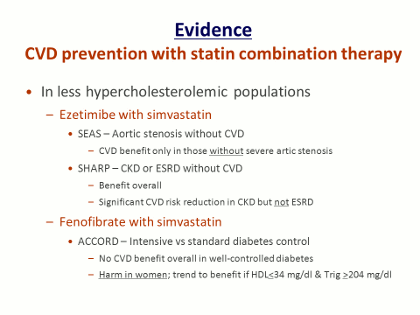Robinson - Figure 12 - Statin combination Rx Text
As with the evidence for non-statin therapy in FH, the evidence for statin combination therapy comes from a very limited database from less severely hypercholesterolemic populations.
One of the first studies was the Simvastatin and Ezetimibe for Aortic Stenosis (SEAS) study,[15] which was done in patients with aortic stenosis who did not have CHD. In this trial there was no overall benefit for simvastatin plus the intestinal cholesterol absorption inhibitor ezetimibe compared with placebo. However, when the top one-third of patients with severe aortic stenosis who went on to undergo coronary artery bypass grafting (CABG) were excluded in a post hoc analysis, a benefit was seen in patients with less severe aortic stenosis. The benefit was of about the same magnitude as would be expected based on the cholesterol treatment trials, and this suggests that adding ezetimibe to a statin may result in some additional benefit
A second study of a statin plus ezetimibe, the Study of Heart and Renal Protection (SHARP),[16] enrolled patients with moderately severe chronic kidney disease (CKD) and dyslipidemia. Again, a prespecified subgroup analysis that excluded certain patients – in this case, patients who had end-stage renal disease and were already on hemodialysis – and looked only at those patients with glomerular filtration rates >15 – 20 mL/min/1.73 m2 found that there was a statistically significant reduction in CHD events that concorded with the degree of LDL lowering in these CKD patients. This analysis supports the use of ezetimibe as add-on therapy to statins; in addition, ezetimibe has excellent results for lowering LDL cholesterol and is very well tolerated by almost all patients.
The only other clinical trial evidence for combination therapy with a statin comes from the Action to Control Cardiovascular Risk in Diabetes (ACCORD) trial,[17] assessing addition of a fenofibrate to treatment with simvastatin. Overall the study result was negative when fenofibrate was added to simvastatin compared to simvastatin alone, but there was a trend toward benefit in those with high triglycerides and low HDL.
The caveat with ACCORD, as with the statin combination therapy trial results, is that the benefits are very modest compared with statin alone. The data with high-dose statins are actually much more robust, regardless of what the baseline lipid values, triglycerides, or HDL levels are. J Clin Lipidol. 2011; 5(6).
References
[15]Rosseb AB, Pedersen TR, Boman K, et al. Intensive lipid lowering with simvastatin and ezetimibe in aortic stenosis. N Engl J Med. 2008;359.
[16]Baigent C, Landray MJ, Reith C, et al. The effects of lowering LDL cholesterol with simvastatin plus ezetimibe in patients with chronic kidney disease (Study of Heart and Renal Protection): a randomized placebo-controlled trial. The Lancet 2011; Published Online June 9, 2011 DOI:10.1016/S0140-6736(11)60739-3
[17]The ACCORD investigators. Effects of combination lipid therapy in type 2 diabetes mellitus. N Engl J Med 2010; DOI: 10.1056/NEJMoa1001282. Available at: http://www.nejm.org/.
